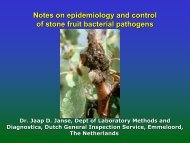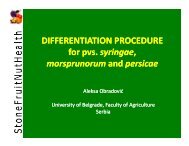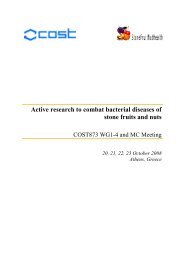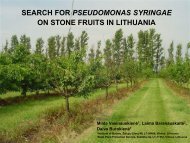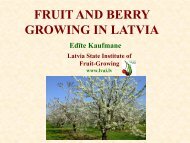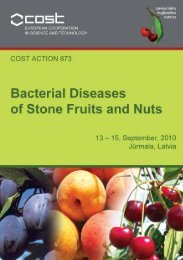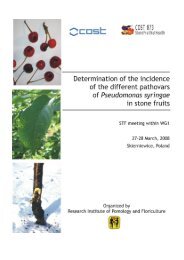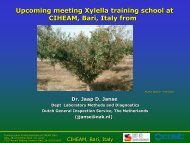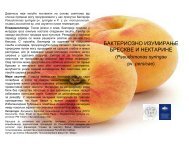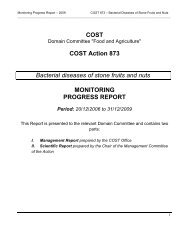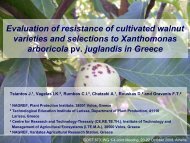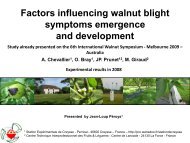Rapid and specific identification of four Agrobacterium ... - Cost 873
Rapid and specific identification of four Agrobacterium ... - Cost 873
Rapid and specific identification of four Agrobacterium ... - Cost 873
Create successful ePaper yourself
Turn your PDF publications into a flip-book with our unique Google optimized e-Paper software.
474ARTICLE IN PRESSJ. Pu"awska et al. / Systematic <strong>and</strong> Applied Microbiology 29 (2006) 470–479Table 1. (continued )Strain Source <strong>and</strong> location Fragments produced in multiplex PCR with primersUF+B1R+B2R+AvR+ArRBiovar 1(184 bp)Biovar 2(1066 bp)A.vitis(478 bp)A. rubi(1006 bp)PCR-RFLP <strong>of</strong>UF+B2Rproduct aPseudomonas syringaepv. tomatoXanthomonas arboricolapv. pruniUnknown; Pol<strong>and</strong>Unknown; Unknownntnta 2, two DNA fragments <strong>of</strong> 1006 bp <strong>and</strong> 60 bp were obtained as a result <strong>of</strong> RFLP with Alw26I; 3, three DNA fragments <strong>of</strong> 830 bp, 167 bp <strong>and</strong> 60 bpwere obtained; nt, not tested.Table 2.Characteristic <strong>of</strong> phenotypic features <strong>of</strong> some <strong>Agrobacterium</strong> strains testedStrain 3-ketolactoseproductionCitrateutilizationL-tyrosineutilizationFerricammoniumcitrateAcid fromerythritolNaCltolerance(%)Oxidase c<strong>Agrobacterium</strong> B6 T (bv.1) + + 4 +<strong>Agrobacterium</strong> Ch 3, 131a/b + + 3 +<strong>Agrobacterium</strong> Ch-6, 137, 6, + + 4 +CFBP 2519<strong>Agrobacterium</strong> 0, 39/7, 7/1 + 4 +<strong>Agrobacterium</strong> LMG 150 T+ + + 1(bv.2)<strong>Agrobacterium</strong> 400 + + + 1 +/<strong>Agrobacterium</strong> 77 + + + 1A. vitis LMG 8750 T + 3 +A. rubi LMG 156 T nt 4 +<strong>Agrobacterium</strong> Ch-11 5 +<strong>Agrobacterium</strong> Ch-12 3 +/<strong>Agrobacterium</strong> 47/7 + + 3 +T , type strain; nt, not tested.Table 3.<strong>Agrobacterium</strong> species/biovar-<strong>specific</strong> primers based on 23S rDNA sequencesName <strong>of</strong> primer Target position a Sequence (5 0 –3 0 )UF f 171–193 GTAAGAAGCGAACGCAGGGAACTB1R r 338–360 GACAATGACTGTTCTACGCGTAAB2R r 1207–1230 TCCGATACCTCCAGGGCCCCTCACAAvR r 640–662 AACTAACTCAATCGCGCTATTAACArR r 1150–1173 AAAACAGCCACTACGACTGTCTTf, forward; r, reverse.a E. coli position numbering [1].Rhizobiaceae which produced a 1066 bp amplificationproduct with primers UF+B2R (Table 1),the restriction analysis <strong>of</strong> this product was applied.On the basis <strong>of</strong> computer analysis, endonucleaseAlw26I was chosen as the most appropriate for thispurpose. For each reaction 50 ng <strong>of</strong> PCR product wasused. Restriction fragments were separated in 2%agarose gels.




